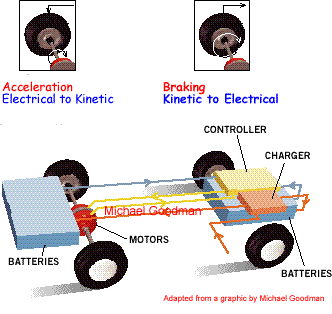|
Regenerative Braking |

In ordinary braking systems the vehicle's kinetic energy is changed into heat energy (and some sound) because most braking systems rely on friction to slow down the vehicle. This is wasted energy because the heat is not put to any useful purpose. Automotive engineers have developed a kind of braking system that can convert much of the car's kinetic energy into electricity, so that it can be used to recharge the car's batteries. This system is called regenerative braking because the kinetic energy is sent to an electric generator rather than just being dissipated as heat. This makes the whole transport system much more efficient as there is less wasted energy. This technology was first used in trolley buses and electric trains but now they have found wider applications. Our need to use less fossil fuels to reduce the Global warming effect we now are making electric vehicles for private use. Regenerative brakes are incorporated in hybrid vehicles (ones that are electric and fuel powered) and in fully electric cars. In vehicles like these, keeping the battery charged is very important. Recharging the battery as you brake allows you to drive further between battery charging sessions. Electric bicycles and even Formula One race cars also make use of this energy efficient idea! For details of how this works click here
|
